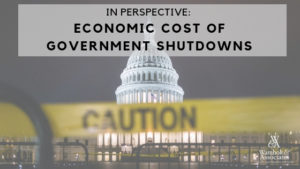The latest partial-government shutdown has been long, and while on reprieve now, may not be laid to rest until a more permanent funding bill is passed by Congress. A shutdown occurs when Congress fails to pass or the President refuses to sign legislation funding federal government operations and agencies.
The most recent shutdown occurred Dec. 21, 2018, when lawmakers failed to enact legislation to fund government programs, leading to the longest ever government shutdown. After a 35-day standoff, a temporary funding bill reopened government on Jan. 25 while congressional negotiators attempt to find a deal on border security. Short a long-term funding agreement, the government could shut down again as early as mid-February when the stopgap funding bill is set to expire.
The record-setting shutdown is far from the only shutdown. Although voters have little appetite for government shutdowns, holding budget negotiations hostage to push through political agendas is now commonplace in the beltway.
Economic cost
Under almost every president since 1976, shutdowns have impacted government operations and cost varying levels of economic losses well into billions of dollars. Lost wages, exports, and government services essential to the operation of private sector businesses are all affected.
Most of the $11 billion in damages to the economy in the latest federal government shutdown will be reversed as federal workers return to their jobs, according to the nonpartisan Congressional Budget Office. However, an estimated $3 billion in economic activity is permanently lost (CNBC).
Funding gaps
There have been over 20 funding gaps in the federal budget, of which 10 have led to federal employees being furloughed. The length of the shutdowns varied from 1 day in 1981 under President Reagan to a minimum of 35 days in 2018/2019 under President Trump.
What shuts down
In the latest shutdown, about 800,000 federal employees in nine Cabinet departments and various smaller agencies were impacted. Some were furloughed without pay while the rest, deemed as “essential”, were required to work without pay.
Departments affected during the most recent shut down include Homeland Security, Housing & Urban Development, Commerce, FCC, Coast Guard, FEMA, Interior, Transportation, and the Executive Office of the President. The closures affect numerous private businesses that rely and adhere to regulatory rules imposed by the Federal government, such as mortgage loans and Housing & Urban Development.
What happens next
Several proposals to end government shutdowns for good have been introduced. In the meantime, lawmakers have until mid-February to hash out a funding deal and avert another shutdown. Should Congress remain at an impasse, the U.S. economy will suffer.
Sources: Congressional Records, https://www.congress.gov/congressional-record/2018/12/22
Follow Us on LinkedIn
Photo by Andy Feliciotti on Unsplash
This commentary on this website reflects the personal opinions, viewpoints and analyses of the Wambolt & Associates employees providing such comments, and should not be regarded as a description of advisory services provided by Wambolt & Associates or performance returns of any Wambolt & Associates Investments client. The views reflected in the commentary are subject to change at any time without notice. Nothing on this website constitutes investment advice, performance data or any recommendation that any particular security, portfolio of securities, transaction or investment strategy is suitable for any specific person. Any mention of a particular security and related performance data is not a recommendation to buy or sell that security. Wambolt & Associates manages its clients’ accounts using a variety of investment techniques and strategies, which are not necessarily discussed in the commentary. Investments in securities involve the risk of loss. Past performance is no guarantee of future results.
Wambolt & Associates provides links for your convenience to websites produced by other providers or industry related material. Accessing websites through links directs you away from our website. Wambolt & Associates is not responsible for errors or omissions in the material on third party websites, and does not necessarily approve of or endorse the information provided. Users who gain access to third party websites may be subject to the copyright and other restrictions on use imposed by those providers and assume responsibility and risk from use of those websites.



